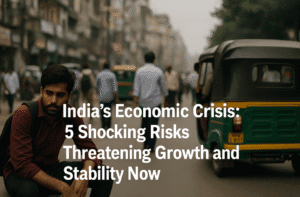India’s Economic Crisis: 5 Shocking Risks Threatening Growth and Stability Now
India’s economic growth faces headwinds as U.S. tariffs dampen business confidence and geopolitical tensions with Pakistan disrupt regional trade. The economy is projected to expand by 6.3% in FY25, a marginal downgrade reflecting sluggish private investment and weak job creation despite robust infrastructure spending. Proposed U.S. tariffs, though targeting minimal goods exports, amplify concerns over protectionism and stalled reforms needed to unlock India’s growth potential.
Meanwhile, retaliatory trade suspensions with Pakistan—halting critical supplies like pharmaceuticals and agricultural goods—threaten Pakistan’s fragile economy, which relies on indirect imports via third countries. Cross-border tensions also endanger humanitarian needs, with Pakistani patients in India facing abrupt medical visa expiries mid-treatment. Economists urge structural overhauls, akin to 1991 liberalization, to spur innovation, jobs, and competitiveness. Balancing security imperatives with economic pragmatism—safeguarding essential trade while countering terrorism—remains key. India’s path forward hinges on revitalizing private sector trust, fostering inclusive growth, and navigating global trade dynamics with strategic agility.

India’s Economic Crisis: 5 Shocking Risks Threatening Growth and Stability Now
India’s economic trajectory faces mounting challenges as external pressures and domestic vulnerabilities collide. A recent Reuters poll underscores a tempered growth outlook, with GDP expected to expand by 6.3% in FY 2024–25—a marginal downgrade from earlier forecasts. While this pace keeps India among the world’s fastest-growing economies, underlying issues like stagnant private investment, job scarcity, and now, escalating trade tensions with the U.S. and Pakistan, threaten to undermine long-term stability.
US Tariffs Cast a Shadow on Business Confidence
The proposed 26% U.S. tariff on Indian goods imports, though paused temporarily, has rattled business sentiment. While India’s exports to the U.S. are predominantly services-driven, the move signals growing protectionism in a critical market. Economists warn that the tariffs could deter foreign investment and exacerbate India’s struggle to revive private sector participation, which has languished for over a decade.
Kunal Kundu, India economist at Société Générale, notes, “India’s growth, while robust, isn’t translating into quality employment. The economy needs a transformative shift akin to the 1991 reforms to unlock its potential.” With middle-class spending on big-ticket items like vehicles and housing slowing, the call for structural reforms—boosting manufacturing, streamlining labor laws, and incentivizing innovation—grows louder.
India-Pakistan Trade Halts: A Double-Edged Sword
The aftermath of the Pahalgam terror attack has intensified cross-border tensions, prompting India to suspend the SAARC Visa Exemption Scheme and halt trade at the Attari-Wagah border. Pakistan retaliated by closing its airspace to Indian flights and scrapping bilateral agreements. While India-Pakistan trade is minimal (just 0.06% of India’s global trade), the suspension disrupts critical supplies to Pakistan, including pharmaceuticals, vegetables, and chemicals, exacerbating its economic strain.
Key Implications:
- Pharmaceutical Dependency: Pakistan relies heavily on Indian drug imports ($208 million in FY25), particularly life-saving medications. Disruptions could deepen its healthcare crisis.
- Third-Party Channels: India may leverage allies like the UAE to tighten indirect trade routes, further isolating Pakistan economically.
- Domestic Fallout: Indian exporters, especially in Punjab’s border regions, face losses, though the broader national impact remains limited.
Human Cost: Medical Tourism in the Crossfire
Geopolitical strife has unintended casualties. Pakistani patients, particularly children undergoing critical surgeries in India, now face abrupt exits due to visa suspensions. Hospitals report frantic efforts to secure extensions for life-saving treatments, highlighting how political decisions ripple into humanitarian crises. “Denying medical visas to critically ill patients punishes the vulnerable,” says Dr. Aashish Chaudhry of Aakash Healthcare.
The Road Ahead: Balancing Growth and Geopolitics
India’s economic resilience hinges on addressing systemic gaps:
- Reviving Private Investment: Infrastructure spending alone isn’t enough. Policy clarity, tax incentives, and easing bureaucratic hurdles are vital to attract capital.
- Job-Centric Growth: With a youth-dominated workforce, sectors like green energy, tech, and SMEs must drive employment.
- Diplomatic Pragmatism: While countering terrorism is non-negotiable, calibrated economic diplomacy—such as safeguarding essential trade—could prevent humanitarian fallout.
Conclusion: A Pivotal Moment for Reform
India stands at a crossroads. External headwinds like U.S. tariffs and internal challenges like weak private investment demand bold reforms. Meanwhile, the Pakistan crisis underscores the delicate balance between national security and economic interdependence. As economists urge a “1991-style” overhaul, the path forward lies in fostering innovation, strengthening domestic markets, and navigating global trade dynamics with strategic foresight. The world’s fifth-largest economy must act swiftly to ensure its growth story benefits all—not just the headline numbers.
You must be logged in to post a comment.